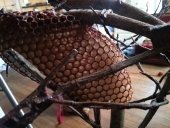


Collection of 14 Permaculture/Homesteading Cheat-Sheets, Worksheets, and Guides
will be released to subscribers in:
soon!











find religion! church
kiva! hyvä! iloinen! pikkumaatila
get stung! beehives
be hospitable! host-a-hive
be antisocial! facespace













find religion! church
kiva! hyvä! iloinen! pikkumaatila
get stung! beehives
be hospitable! host-a-hive
be antisocial! facespace




there's some disagreement about the timing of the fight to the death between remaining queens. the prevailing wisdom seems to be that the first queen hatched immediately sets about stinging any un-hatched queens to death. if more than one manage to hatch, they will battle. then the one survivor will go on a mating flight.
 i used to tend 10,000-30,000 hives annually , heavily manipulated commercial hives, saying that , limits how much time i could observe any single hive and it's dynamics.... Also ALL the queening we did was artificial so all queens emerged at once.. so not as versed as i should be other than texts i have read .... Personally i do agree that a natural swarm queen is the strongest.... And why i spoke of "emergency Queens" as they usually undersized and at best , average genetics, there are tricks to making them stronger , though it's a system i personally don't favor..... But each to their own
i used to tend 10,000-30,000 hives annually , heavily manipulated commercial hives, saying that , limits how much time i could observe any single hive and it's dynamics.... Also ALL the queening we did was artificial so all queens emerged at once.. so not as versed as i should be other than texts i have read .... Personally i do agree that a natural swarm queen is the strongest.... And why i spoke of "emergency Queens" as they usually undersized and at best , average genetics, there are tricks to making them stronger , though it's a system i personally don't favor..... But each to their own 




tel jetson wrote: ... a broodless period helps with mite loads....









find religion! church
kiva! hyvä! iloinen! pikkumaatila
get stung! beehives
be hospitable! host-a-hive
be antisocial! facespace




I cant say i have seen this due to the nature of the way our hives have been manipulated , any queen after mating doesn't leave the nest , as all queen cells are squashed and hives expanded to keep her in , if hive numbers start to drop off because the queen gets "old" she's usually removed and replaced by a fresh "emergency queen", I have read exactly as you describe , But not something i have witnessed first handgenerally the existing queen that leaves with the first swarm of the season, called the prime swarm, before any new queens have hatched. prime swarms are frequently followed by one or more cast swarms that will each include a young queen.






find religion! church
kiva! hyvä! iloinen! pikkumaatila
get stung! beehives
be hospitable! host-a-hive
be antisocial! facespace




David Williams wrote:I cant say i have seen this due to the nature of the way our hives have been manipulated , any queen after mating doesn't leave the nest , as all queen cells are squashed and hives expanded to keep her in , if hive numbers start to drop off because the queen gets "old" she's usually removed and replaced by a fresh "emergency queen",









David Williams wrote:A lot of the selection criteria for "emergency queens" were about less aggressive / more production orientated ... and less about what was suited to any individual area or cold climate production ect
find religion! church
kiva! hyvä! iloinen! pikkumaatila
get stung! beehives
be hospitable! host-a-hive
be antisocial! facespace








Living in Anjou , France,
For the many not for the few
http://www.permies.com/t/80/31583/projects/Permie-Pennies-France#330873





David Williams wrote:@ Tel, you'll find the remaining bees after the yellow jacket invasion are more resistant , If you de-queen them and they make a new one , you will find the whole colony will be more resistant to future attacks.. A general rule we use out here is the color of the queen also determines the temperament, Darker colored queens usually have more resistance to disease / pests , with slightly less production , and ones with more yellow have higher yield and more docile and more vulnerable to outside influences... there is always exceptions to this rule of course , tho noticeable over the amount of hives i used to tend
find religion! church
kiva! hyvä! iloinen! pikkumaatila
get stung! beehives
be hospitable! host-a-hive
be antisocial! facespace









find religion! church
kiva! hyvä! iloinen! pikkumaatila
get stung! beehives
be hospitable! host-a-hive
be antisocial! facespace

|
I've never won anything before. Not even a tiny ad:
Homestead Pigs Course
https://permies.com/wiki/365748/Homestead-Pigs
|

